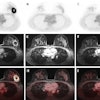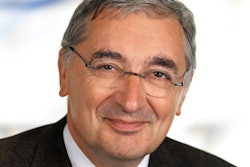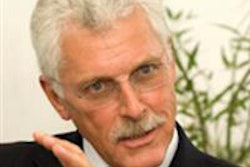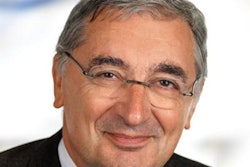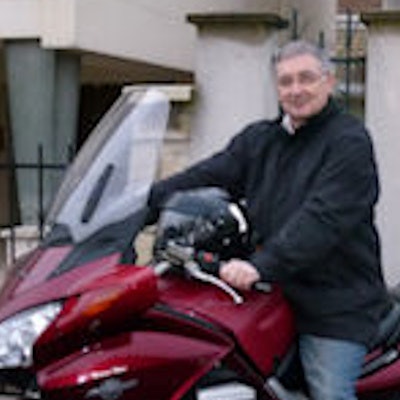
The European Society of Radiology (ESR) this week unveiled Dr. Yves Menu as the new editor in chief of its journal European Radiology. He will take over from Dr. Maximilian Reiser later this year and serve a three-year term.
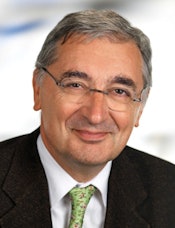 Dr. Yves Menu will step down progressively in 2018 as chair of radiology and nuclear medicine at several Paris hospitals.
Dr. Yves Menu will step down progressively in 2018 as chair of radiology and nuclear medicine at several Paris hospitals.Menu's top priority is to maintain the journal's high-quality status while improving certain editorial aspects, such as timelines and peer review, in an attempt to attract noteworthy research and increase the number of citable articles published.
"For improved impact factors, journals have to publish the best papers. Attracting highly citable articles is of prime importance," he told AuntMinnieEurope.com. "Papers that summarize recommendations for clinical practice and standard of care are always well received and they should reach as wide a readership as possible, so it's a win-win situation for the authors, the readers, and the journal."
An example of the popularity of guidelines-based articles is the European Society of Urogenital Radiology's (ESUR) paper on prostate imaging guidelines (European Radiology April 2012, Vol. 22:4, pp. 746-757), said Menu, who is a member of the board of directors at Saint-Antoine Hospital in Paris and was president of ECR 2011. The ESUR article was cited over 165 times during the "useful citation" period (2013 and 2014).
Emphasis on timelines
Improving timelines will be vital to the future success of the journal, Menu added.
"Managing the internal life of a manuscript is a race against the clock, and we should make every effort to eliminate wasted time," he noted. "Authors always appreciate a timely response, as well as constructive and objective criticism that will help them to improve their paper, potentially allowing them to resubmit it when rejected."
Improving peer review also is a continuous process, according to Menu. He hopes in 2018 to simplify the reviewers' task and to increase the recognition they deserve. He plans to introduce the option of a fast-track review for "hot topics."
"Authors will be informed of the possibility to ask for a fast review if they feel that their work is a major scientific advance that should be published as quickly as possible. Obviously the editorial board will hold the final decision for the fast track, however, this might guarantee a noticeable improvement for highly productive and efficient academic teams, who are important partners of the journal," he said.
A single European journal?
Some in the radiological community believe there is no real need for a duplication of effort with two Europe-focused imaging journals, but Menu is convinced there is enough room for both European Radiology and the European Journal of Radiology (EJR).
"Given the number of submissions, there is a need for more than one academic journal in Europe. Acceptance rate in European Radiology is less than 20% and there are probably similar figures for the EJR," he said. "I imagine that, due to differences in impact factor, authors may send to our journal first, but I enjoy reading articles in EJR too and there is clearly enough material to fill two monthly journals."
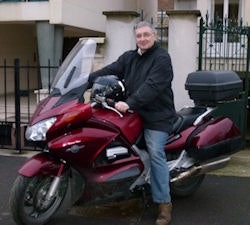 Menu, a motorbiking enthusiast, likes to play hard and work hard.
Menu, a motorbiking enthusiast, likes to play hard and work hard.
Menu states that as a reviewer for several imaging publications in recent years, occasionally he has come across the same paper submitted successively to two different journals after rejection from the first.
Although European Radiology's impact factor declined from 2013 to 2015, he pointed to the same pattern for many other journals during this period. He also flagged up an increase in the journal's newly published impact factor of 3.97 for 2016, compared with that of 3.6 for 2015.
Menu underlined that the cycle for compiling each set of figures is around three years and that other niche journals which publish far fewer papers will sometimes have extremely high impact factor scores. This score also doesn't take into account other metrics such as the Eigenfactor score, which translates not only the number of citations but also the importance of the journal where the citation is found, he added.
The editorial team
The highly motivated and skilled professionals in the editorial team will essentially remain unchanged, according to Menu.
"Many have expressed their will to continue the adventure, and this is good news. In my opinion, it highlights the quality of Max Reiser's management," he said, adding that ESR members will still have online access to the journal through their membership fee.
Menu thinks his new duties will take up around 75% of his professional time. While stepping down progressively through 2018 from his post of chair of radiology and nuclear medicine across several hospitals in Paris, he will still be working the equivalent of one full day a week at St Antoine Hospital in a clinical and educational capacity. He stresses that keeping a link with patients and students is certainly beneficial, even for editorial tasks.
He admits his new role will require considerable advance planning and hard work. Menu is already deputy editor at European Radiology, and he confirms that the articles for all 2017 editions have already been selected. Analysis of articles for the January 2018 edition, when he officially takes over, has already begun, and from now on Menu and the team will consider two to three articles a week for publication in early 2018.
Looking to the future
So what new elements will readers enjoy? According to Menu, a "new skin," as well as an increase in the manuscript selection, are being considered.
"We are thinking of some new features; however, we need to have a team discussion, and it would be a little bit premature to make announcements today," he said.
According to today's ESR statement, Menu will focus on establishing the journal as Europe's No. 1 general journal for clinical radiology.
European Radiology was founded in 1991 and is supported by nearly 70,000 ESR members worldwide and by publishing house Springer Nature. It is one of the most read publications in the field, gaining over 620,000 article downloads in 2016 from an international readership, ESR stated.
Career highlights
- Originally from Dijon in the east of France, Dr. Yves Menu graduated from the University of Paris VI Medical School in 1976 and began his residency in neurosurgery, endocrinology, and radiology at the Assistance Publique Hôpitaux de Paris and University of Paris in 1977.
- He became a board-certified radiologist in 1981 and then a fellow at Beaujon Hospital's in Clichy. At Beaujon, he became professor of radiology, and in 1990 was made chairman of radiology at Bichat Hospital in Paris.
- Menu returned to Beaujon Hospital in 1993 and served as chair of radiology until 2003, when he became the chairman of Bicêtre Hospital's department of radiology and a professor of radiology at the University of Paris XI.
- His main areas of interest are gastrointestinal radiology, oncologic imaging, and emergency radiology. He has published 191 peer-reviewed scientific articles, 19 book chapters, and a book. He has delivered 290 lectures, presentations, and invited talks.
- From 1992 to 1996, he was editor in chief of the Journal de Radiologie, the official journal of the French Society of Radiology and served as reviewer for Intensive Care Medicine, European Journal of Radiology, Gastroentérologie Clinique et Biologique, Translational Oncology, and Radiology. In 2010, he received the Editor's Recognition Award from Radiology and became an associate editor of this journal.
- Menu was president of the European Society of Gastrointestinal and Abdominal Radiology (ESGAR) from 2009 to 2011 and president of the ESGAR congress in 2015.
- He was president of ECR 2011, chairman of the ESR Professional Organisation Committee from 2011 to 2013, and was scientific director of the European Board of Radiology from 2013 to 2015.
- He is an honorary member of the RSNA, Tunisian Society of Radiology, and the Romanian Society of Radiology.
- Menu received the ESR Gold Medal at ECR 2015, and he was president of the 2016 Journées Francophones de Radiologie Diagnostique et Interventionnelle (Francophone Congress of Diagnostic and Interventional Radiology, JFR), held in Paris last October.




